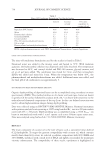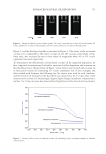739 ENHANCED NATURAL OIL DEPOSITION leave-in treatment is common in a subset of the world, the inclusion of coconut oil in standard shampoos and conditioners is growing rapidly as consumers desire more natural benefit agents. In this section we explored a standard rinse-off conditioner that contained either 2% coconut oil or 2% coconut oil structured with 6% of acrylic copolymer. It is important to highlight that the polymer use level in these conditioners is a fraction of a percent, more specifically 0.12% by weight, of the finished formulation. As shown in Figure 8, improvements in both dry combing and wet combing were observed when the coconut oil in the rinse-off conditioner formulation was structured with acrylic copolymer. The control is hair without any rinse-off conditioner treatment, “oil only” is the rinse-off conditioner with unstructured coconut oil, and the “6% acrylic copolymer” sample is the rinse-off conditioner with structured coconut oil. The results show that the polyacrylate-containing oil gels formulated in the rinse-off conditioners provided an improvement in the reduction in wet combing force compared to the control conditioner without such polymers. The conditioners containing the polyacrylate-containing oil gels are therefore capable of significantly improving the wet conditioning properties of hair. Additionally, statistically significant benefits were observed in dry combing, which can lead to easier brushing and overall reduced damage. Lastly, the impact of the structured-oil rinse-off conditioner treatments were explored using a coefficient of friction study on dry hair. Conditioners containing the structured coconut oil containing 6% copolymer provided an improvement for reduced friction compared to the control conditioner with unstructured coconut oil (Figure 9). No benefit was observed for rinse-off conditioners containing structured coconut oil with only 2% copolymer (data not shown). In summary, the impact of acrylic copolymers on the deposition and retention of coconut oil on hair fibers has been studied. We have shown that structuring coconut oil can increase the overall viscosity of the oil and increase the amount of oil that is retained on the hair after leave-in treatment followed by shampooing. GC–MS was used to quantify the amount retained on hair upon washing, and it was found to be roughly 2% of the amount 0 0.1 0.2 0.3 0.4 0.5 0.6 0.7 0.8 0.9 1 Control Oil Only 6% Acrylic Copolymer Conditioner Treatment Dry Force Wet Force Figure 8. Average wet (green) and dry (blue) combing force on 8 hour bleached hair tresses after treatment with rinse-off conditioners containing structured or unstructured coconut oil. Average Combing Load
740 JOURNAL OF COSMETIC SCIENCE applied, doubling the amount retained from the neat coconut oil treatment. Using SIMS, we have shown the colocalization of the acrylic copolymer and coconut oil, and through depth profiling, we have shown that the small, more migratory coconut oil is present in greater quantities at the air interface. We have explored the utility of those structured oil gels as neat leave-in treatments as well as the key benefit agent in rinse-off conditioners. In the leave-in treatments, we have shown significantly reduced dry combing force relative to unstructured coconut oil. For the rinse-off conditioners, benefits were observed for dry and wet combing, and reduced friction was measured with 0.12% acrylic copolymer in the formulation. REFERENCES (1) S. Kappally, A. Shirwaikar, and A. Shirwaikar, Coconut oil—a review of potential applications, Hygeia J. D. Med., 7(2), 34–41 (2015). (2) G. Deckner, Coconut Oil: A Personal-Care Powerhouse, Prospector, July 22, 2016, accessed February 16, 2022, https://knowledge.ulprospector.com/4713/pcc-coconut-oil-a-personal-care-powerhouse/. (3) A. S. Rele and R. B. Mohile, Effect of coconut oil on prevention of hair damage part I, J. Cosmet. Sci., 50, 327–339 (1999). (4) A. S. Rele and R. B. Mohile, Effect of mineral oil, sunflower oil, and coconut oil on prevention of hair damage, J. Cosmet. Sci., 54, 175–192 (2003). (5) T. V. Drovetskaya, L. Kreeger, J. L. Amos, C. B. Davis, and S. Zhou, Effects of low-level hydrophobic substitution on conditioning properties of cationic cellulosic polymers in shampoo systems, J. Cosmet. Sci., 55, 195–205 (2004). (6) L. Bai, L. Chen, Y. Chen, S. Golden, J. Koenig, L. Leal, X.-Q. Liu, O. Young, and F. Zeng. (2020) Oil Cleanser Composition (U.S. Patent No. 10,864,155 B2). U.S. Patent and Trademark Office. (7) M. D. Berthiaume, Silicones in hair care, Society of Cosmetic Chemists, Monograph Series, 4–5 (1997). 0 0.2 0.4 0.6 0.8 1 1.2 1.4 1.6 Control Unstructured Oil Structured Oil COF with cug415cle COF against cug415cle Figure 9. Coefficient of friction (COF) study on 8 hour bleached hair after rinse-off conditioner treatment. Coefficient of Fricg415on
Purchased for the exclusive use of nofirst nolast (unknown) From: SCC Media Library & Resource Center (library.scconline.org)






































































































































